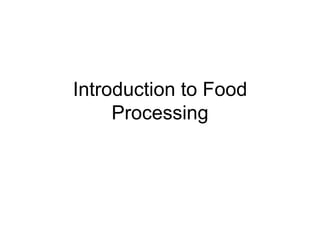3-1introductiontofoodprocessing-100302145900-phpapp02.pdf
- 2. Why process foods? • Extend edible time frame -Preservation • Make better tasting foods • Make more varieties of food • Convenience
- 3. Drying • Extraction of moisture by sun, air, heat or vacuum to inhibit the growth of molds, bacteria and yeasts – Name 3 dried foods
- 4. Salting • The addition of salt or a brine solution to foods to decrease the activity of molds, bacteria and yeasts. – Name 3 salted foods
- 5. Curing • The addition of a chemical compound (sodium nitrate or sodium nitrite) to food to slow the growth of bacteria. – Name 3 cured foods
- 6. Fermentation • The use of special bacteria, molds or yeasts to prevent spoilage by converting the elements of food that spoil easily to stable elements that act as preservatives. – Name 3 fermented foods
- 7. Freeze Drying • The freezing of food and the subsequent removal of water from the frozen food through the use of heat and a vacuum.
- 8. Smoking • The addition of smoke and heat to preserve food by the action of the chemicals from the smoked wood and the partial drying of the food. – Name 3 smoked foods
- 9. Canning/Aseptic Packaging • The packing of food in a container, sealing the container and heating it to sterilize the food. – Name 3 canned foods
- 10. Pasteurization • The heating of milk and other liquids which reduces the number of disease- producing bacteria. – Name 3 pasteurized foods
- 11. Refrigeration • The lowering of the temperature of food to inhibit the growth of bacteria, molds and yeasts. – Name 3 refrigerated foods
- 12. Freezing • The lowering of the temperature of food to temperatures below 28 degrees F to stop the growth of bacteria, yeasts and molds and to kill parasites. – Name 3 frozen foods
- 13. Food concentration • Heating food until it boils and removing the water or partially freezing food and removing water in the form of ice crystals. – Name 3 concentrated foods
- 14. Irradiation • Passing energy through food to destroy insects, fungi, or bacteria that cause human disease or cause food to spoil. – Name 3 irradiated foods
- 15. Food Safety • HAACP: Hazard Analysis Critical Control Point • What safety risk is present for each food – Pathogenic microorganisms • Bacteria, viruses – Spoilage microorganisms • Fungi, bacteria • What foods are at greatest risk for contamination?
- 16. Most important qualities to control • pH – Bacteria thrive in a pH neutral environment (7) – Items with pH above 8 tend to be very bitter & toxic – Foods with pHs below 6 tend to be tart or sour 1 7 14 Bacteria Yeast/Fungi
- 17. Qualities to control • Temperature • 40 – 140°F = the temperature danger zone – Rapid multiplication of microorganisms • <40°F very slow growth • <28°F – no growth – no death • >140°F – death of microorgamisms
- 18. Qualities to Control • Moisture content & Protein content • Bacteria need a high moisture content • Fungi can grow in lower moisture – Dry foods won’t make you sick – Dry foods do spoil • Bacteria need protein, fungi less so – Candy & carbohydrates may spoil but don’t won’t make you sick
- 19. Food Deterioration • Enzymes break down proteins over time – Must deactivate enzymes before food can be stored – Heat destroys enzymes • Fats and oils can oxidize in storage – Gives off flavors – Need airtight packaging or antioxidant additives


















